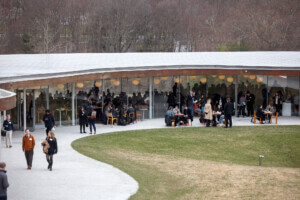California College of the Arts, I learned recently, is in the process of building over an Indigenous site to expand its campus. At the same time, the college’s public lectures routinely begin with a land acknowledgment. This tension—between a growing consciousness that we all live in an ongoing colonialist project and uncertainty as to exactly what can be done about it—lies at the center of the discussions around decolonization in architecture.
Colonization, understood historically, is the forcible displacement of Indigenous peoples from their land for the purposes of extraction and, in nations like the U.S., expansion. This inherently exploitative process is crucial for the accumulation of resources, capital, and, ultimately, power, through which ruling classes have dominated and subjugated the rest of the world. And it all continues to the present day: The construction of the Dakota Access Pipeline (DAPL), announced in 2014 and completed in 2017, relied on the displacement and endangerment of thousands of Indigenous people. Put bluntly, colonization has been an indispensable part of establishing our current world order, capitalism.
Architecture has served as a tool within that process. For Léopold Lambert, editor of the Paris-based magazine The Funambulist, “no other discipline is better at implementing settler colonialism,” since architecture occupies land and imposes ways of being on that land.
As the framework of decolonization in architecture has taken further root, the term, Lambert suggests, can create more questions than it answers. Looking to the U.S. context, there is the question of what can be done within the academy, in terms of educating students to better understand the country’s history of colonization. There is the question of what can be done within the profession, in terms of ensuring architects know how to work with Indigenous clients and on Indigenous sites—and whether non-Indigenous architects should be doing this work at all. And there is, of course, the question of whether any of these changes can happen within the field without society at large changing first.
The first question seems most easily answerable. Summer Sutton, an architecture Ph.D. student studying questions of decolonization at Yale University and a member of the Lumbee Tribe of North Carolina, tells me that there is much progress to be made on this front. “I don’t think it’s just up to academia to be the voice of decolonization, but there is room to incorporate more voices,” Sutton said.
Andrew Herscher and Ana María León, cofounders of the Settler Colonial City Project (SCCP) and faculty at the University of Michigan, have contributed to such efforts. They founded SCCP in 2019, aiming to, in their own words, collaboratively produce “knowledge about cities on Turtle Island/Abya Yala/The Americas as spaces of ongoing settler colonialism, Indigenous survivance, and struggles for decolonization.” At that year’s Chicago Biennial, their intervention sought to bring attention to the stolen Indigenous land on which the Chicago Cultural Center, the event’s primary venue, stands and to the legacy of colonial extraction and displacement on which the production of architecture relies.
Herscher and León see their efforts as “first steps” to educate and move architects toward a decolonizing practice. “It’s not just in the way architecture is practiced,” León said. “It’s also in the way it’s taught and reproduced.”
Still, architecture ultimately is produced through its practice. Here, the immediate next steps are less clear. Chris Cornelius, founder of the architecture firm studio:indigenous and citizen of the Oneida Nation of Wisconsin, suggests that decolonizing architectural practice would necessarily entail efforts to understand the cultures and practices of communities architects build for, especially Indigenous communities. According to Cornelius, architects should seek to work closely with their clients, understanding them as people, and using that understanding to produce a more “empathetic” architecture. Certainly, this is a practice individual architects can take up, but because colonization is inextricably linked to larger political and economic systems, could the effects of such efforts extend beyond a specific project, client, or firm?
“I don’t think we can decolonize architecture,” Lambert admits. “That does not mean that architecture can’t be part of a decolonial political agenda, but even in that case it’s serving that agenda; the architecture itself doesn’t decolonize.”
Because architecture is implicated within the broader process of colonization, it would be impossible to simply decolonize architecture without dismantling the larger system to which both it and colonization itself belong. That is a much more difficult and challenging task than, say, making changes to curricular, or even disciplinary, structures.
Proponents of decolonization within architecture, design, and the built environment recognize what a daunting task that is, as well as the absolute need for political organizing to carry it out. Dr. Sharon Sutton, author of When Ivory Towers Were Black: A Story about Race in America’s Cities and Universities, believes youth movements can play a crucial role in fomenting change, akin to the way her own generation, which grew up in the post–World War II years, compelled powerful institutions (Columbia in Sutton’s case) to adopt more equitable policies in the wake of the civil rights movement. Yet, Sutton acknowledges that today’s students are quite different from their ’60s counterparts. The former are less marginalized than the latter, less working-class, and more integrated into the system. “We make them servants of neoliberal capitalism,” she said.
Perhaps for this reason, Herscher and León point instead to the leadership of grassroots Indigenous activists, like those who led the efforts to stop DAPL at Standing Rock. “It’s impossible to decolonize architecture from within architecture,” said Herscher. “That’s a process that relies on architecture’s connection to on-the-ground political movements for decolonization.”
Such movements, however, can work to prevent architects from perpetuating their profession’s colonizing role. For example, in 2019 The Funambulist called on the French architect Jean Nouvel to back out of a project to “revitalize” the Casbah in Algiers, a key site of the Algerian struggle against French colonialism. “Unfortunately,” the 400-signature-strong petition read, “there is no Hippocratic Oath for architects that would prevent anyone from designing a project harmful to the inhabitants of a given site—many architectural firms would then have to go out of business!” Though the effort ultimately proved unsuccessful—Nouvel offered a testy response and did not drop the commission—it represents one type of activity through which designers can be held accountable for their work.
The notion of a professional oath squares with recent efforts to enforce guidelines that would prevent architects from designing prisons. But for Herscher and León, decolonization has less to do with compulsory guidelines and belongs, rather, to a broader project of “coliberation,” as León says. This project, in turn, is tied up with other liberatory movements such as feminism and antiracism. “Talking about the way colonization dehumanizes those of us it benefits makes decolonization not giving up something but gaining something: gaining a way to be human that doesn’t rest upon the oppression and domination of others,” said Herscher.
Looking to move beyond decolonization as a slogan into thinking about what specific next steps would be necessary to realize it in the world quickly brings to the fore the central issue: The problem is not the practice of architecture, but the system to which it belongs. Following that, a decolonizing view of architecture has to take into account what most people in the field have in common—we are not in power—and understand colonization as a process that exists within a larger extractive capitalist project. The decolonization push within the discipline should drive architects to see themselves as activists—and to then act accordingly—if they want to bring about such deep change.










